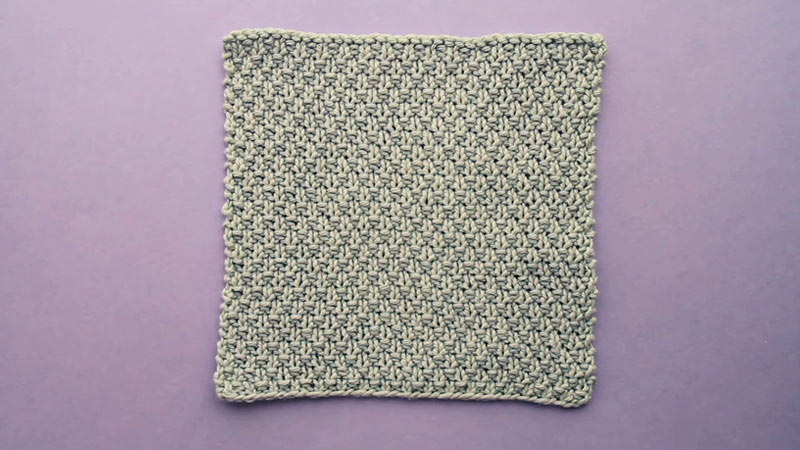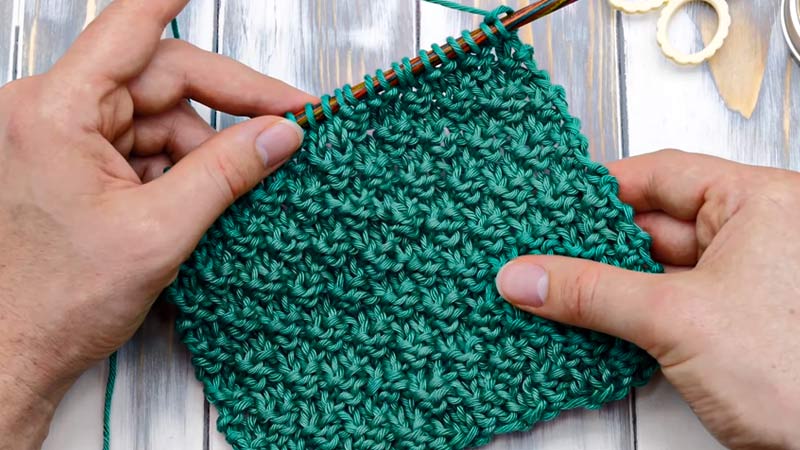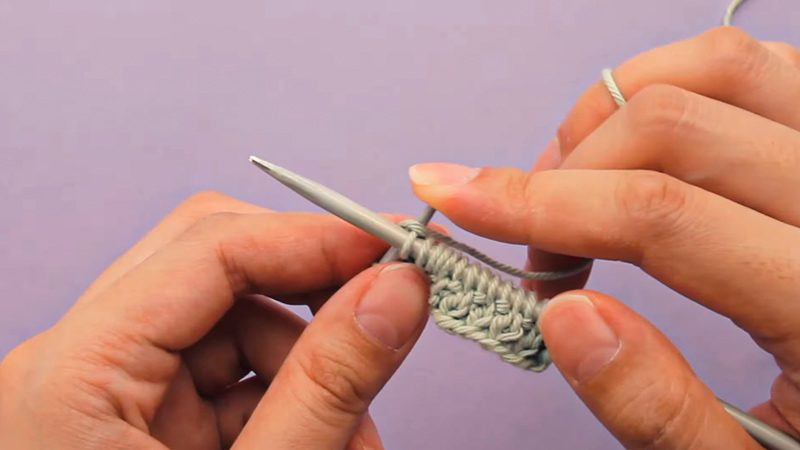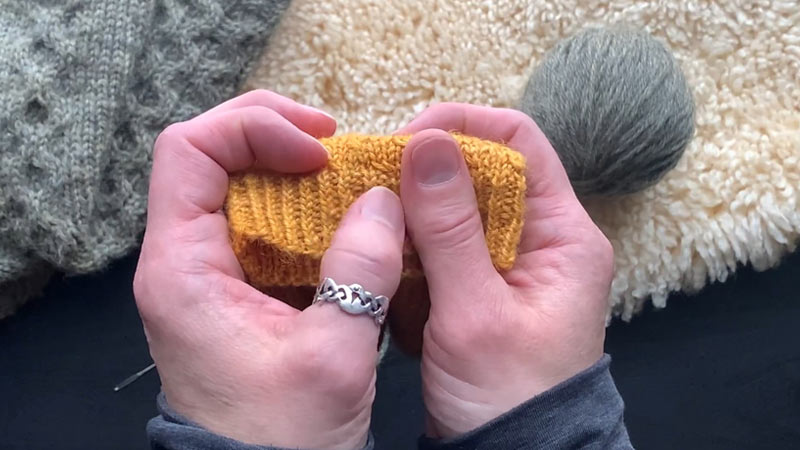Moss stitch, a classic in the knitting lexicon, weaves a tale of simplicity and versatility. Also known as seed stitch, this textured pattern relies on the rhythmic dance of knit and purl stitches, creating a fabric adorned with small, distinctive bumps.
With a reversible charm, moss stitch captures knitters’ hearts, offering a visually appealing surface that mirrors elegance and warmth.
Suitable for both beginners and experienced crafters, its ease of memorization and adaptability make it a go-to choice for various projects, from cosy scarves to intricate blankets.
Discover the artistry of Moss Stitches as it unfolds with each meticulous knit and purl.

What Is Moss Stitch in Knitting?
Moss stitch, or seed stitch, is a straightforward yet versatile knitting pattern. Achieved by alternating knit and purl stitches in a consistent sequence, moss stitch creates a textured fabric with small bumps or “mosses.”
Rows alternate between K1, P1 and P1, K1, resulting in a reversible fabric that looks the same on both sides. This stitch produces a dense, warm fabric, making it ideal for cold-weather projects.
Moss stitch is appreciated for its simplicity, memorizable pattern, and ability to add visual interest to various knitting projects, from scarves to blankets, making it suitable for both beginners and experienced knitters.
6 Types of Moss Stitch in Knitting
Moss stitch, or seed stitch, is a versatile knitting pattern that can be adapted and modified to create various textures and designs.
Here are different types of moss stitch variations in knitting:
1. Standard Moss Stitch or Seed Stitch
The classic moss stitch involves alternating knit and purl stitches within the same row. In one row, you knit one stitch and purl the next; then, you reverse the pattern in the next row by purling the knit stitches and knitting the purl stitches.
This creates a textured fabric with a subtle, evenly distributed pattern.
2. Double Moss Stitch

Double moss stitch adds a more pronounced texture by repeating a four-stitch sequence. In one row, you knit two stitches and purl two stitches, and in the next row, you reverse the pattern by purling two stitches and knitting two stitches.
This results in a grid-like pattern with larger bumps.
3. Half or Single Moss Stitch
You maintain the same knit and purl sequence for two consecutive rows before switching in half or single moss stitch. This simplification retains the essence of Moss Stitched while creating a slightly different texture.
4. Moss Stitch Checkered Pattern
This variation introduces a checkered effect by alternating between rows of knit two, purl two, and purl two, knit two. The staggered placement of knit and purl stitches creates a visually interesting checkered pattern.
5. Brick Stitch (Alternating Rows of Moss Stitch)
The brick stitch variation combines moss stitch with an alternating brick-like pattern. In one row, you knit one, purl one, and in the next row, you reverse the pattern by purling one, knitting one. This creates a textured surface reminiscent of brickwork.
6. Irish Moss Stitch
The Irish Moss Stitch is a more intricate variation with a four-row repeat. It involves alternating between knit and purl stitches in a specific sequence, creating a textured fabric with a more complex design. The Irish Moss Stitch is often associated with traditional Aran knitting.
How to Do Moss Stitch in Knitting for Beginners? 7 Steps

Moss stitch is a great pattern for beginners as it only involves basic knit and purl stitches. Here’s a step-by-step guide on how to knit moss stitch for beginners:
Materials Needed
- Yarn
- Knitting needles
Instructions:
Step 1: Casting On
Begin by casting on an even number of stitches using your preferred method. This initial step lays the foundation for your Moss Stitched project.
Step 2: Row 1 – Knit One, Purl One (K1, P1)
Initiate the first row by knitting the first stitch, then transition to purling the next. Repeat this sequence (K1, P1) across the entire row, ensuring an even number of stitches.
Step 3: Row 2 – Purl One, Knit One (P1, K1)
Advance to the second row, where you’ll reverse the pattern. Start by purling the first stitch, followed by knitting the next. Repeat (P1, K1) across the row.
Step 4: Repeat Rows 1 and 2
Continue the alternating pattern between Rows 1 and 2 until your knitted piece reaches the desired length. The simplicity of Moss Stitches lies in this rhythmic repetition.
Working in the Round (For Circular Projects):
Step 5: Round 1 – Knit One, Purl One (K1, P1)
Adapt the moss stitch for circular projects by starting with a round of knitting the first stitch and then purling the next. Repeat the pattern (K1, P1) for the entire round.
Step 6: Round 2 – Purl One, Knit One (P1, K1)
Proceed to the second round, where you purl the first stitch and knit the next. Repeat the pattern (P1, K1) for the entire round.
Step 7: Repeat Rounds 1 and 2
Consistently alternate between Rounds 1 and 2 for circular projects until the desired length is achieved.
Why Use Moss Stitch? Discover the Benefits

Moss stitch offers several advantages that make it a popular choice for knitters in various projects. Here are some reasons why you might choose to use moss stitch:
Reversible Texture
Moss stitch creates a fabric with a textured pattern that looks the same on both sides. This is advantageous for items like scarves and blankets, where both sides may be visible. The reversible nature adds versatility to the finished product.
Dense and Warm Fabric
The alternating knit and purl stitches in moss stitch create a dense fabric that traps air, providing insulation and warmth. This makes it an excellent choice for cold-weather accessories like hats, scarves, and mittens.
Textured Interest
Moss stitch adds visual interest and dimension to your knitting projects. When combined with other stitch patterns or on its own, moss stitch can break the monotony of plain stockinette or garter stitch, adding a touch of texture and complexity.
Ease of Memorization
Moss stitch is relatively simple to memorize, making it an excellent choice for knitters who enjoy projects they can work on without constant reference to a pattern. This simplicity makes it accessible for beginners as well.
Relaxing and Enjoyable
Many knitters find Moss Stitched to be a relaxing and enjoyable pattern to work on. The repetitive nature of alternating knit and purl stitches can be soothing, making it a great choice for stress-free knitting.
Versatility
Moss stitch is versatile and can be used for various projects, from accessories like scarves and hats to larger items like blankets and sweaters. Its adaptability makes it suitable for various styles and purposes.
Timeless Aesthetic
Moss stitch’s classic look gives it a timeless aesthetic. Whether used in traditional or modern designs, moss stitch adds a touch of sophistication to the finished piece.
Beginner-Friendly
For those new to knitting, Moss Stitches is an excellent starting point. It involves basic knit and purl stitches, helping beginners practice and build confidence in their knitting skills.
Tips and Tricks for Moss Stitch In Knitting

Perfecting Moss Stitches in knitting can be a rewarding experience, and adopting some tips and tricks can elevate your skills.
Here’s a guide to enhance your moss stitch projects:
Yarn Choice
Opt for a smooth and well-defined yarn. Moss stitch looks best with a yarn that highlights the texture. Avoid using overly fuzzy or textured yarns that may obscure the stitch pattern.
Needle Size
Choose needles that complement your yarn weight. Using the recommended needle size ensures that your stitches are even and the fabric has the desired drape.
Even Number of Stitches
Start with an even number of stitches for moss stitch to maintain the alternating pattern. This helps create a balanced and symmetrical fabric.
Edge Stitches
Consider adding edge stitches to your moss stitch project. A border of knit or purl stitches can create a neater finish and make it easier to keep track of the pattern.
Tension Control
Pay attention to your tension. Consistent tension is crucial for achieving an even and attractive moss stitch. Practice maintaining the same level of tension throughout your work.
Use Stitch Markers
Place stitch markers between pattern repeats or at the edges to help you keep track of the alternating stitches, especially in larger projects.
Count Your Stitches
Regularly count your stitches at the end of each row or round to catch any early mistakes. Moss stitch can be easy to lose track of, so counting helps ensure accuracy.
Practice on a Small Project
If you’re new to Moss Stitches, start with a small project like a dishcloth or a swatch. This allows you to practice the stitch without committing to a larger piece.
Alternate Colors
Experiment with colour changes to add visual interest. Alternating colours every few rows can create a striped effect and showcase the texture of the moss stitch.
Relax and Enjoy
Moss stitch can be repetitive, but it’s also relaxing and satisfying. Embrace the rhythm of the pattern and enjoy the process.
Blocking
Consider blocking your finished moss stitch project to even out the stitches and enhance the overall appearance. Blocking helps the texture shine and gives your project a polished look.
Check Gauge
Always check your gauge before starting a larger project. Moss stitch can affect gauge, and ensuring accuracy will help you achieve the correct size and fit.
FAQs
What projects are suitable for moss stitch?
Moss stitch is versatile and suitable for various projects, including scarves, blankets, hats, and sweaters. Its reversible nature makes it ideal for items without a distinct wrong side.
Is moss stitch suitable for beginners?
Yes, moss stitch is beginner-friendly. Its simple pattern involves basic knit and purl stitches, making it accessible for those new to knitting.
Can moss stitch be combined with other stitch patterns?
Yes, moss stitch can be creatively combined with various knitting stitches to produce unique textures. Experimenting with cables or lace alongside moss stitch can result in distinctive designs.
Is there a difference between British moss stitch and American moss stitch?
The terms “British moss stitch” and “American moss stitch” are often used interchangeably. Both refer to the same knitting pattern involving alternating knit and purl stitches to create a textured fabric.
To Recap
Moss stitch stands as a timeless testament to the artistry embedded in the world of knitting. Its simplicity, achieved through the interplay of knit and purl stitches, transforms yarn into a fabric that is visually captivating and imbued with warmth and texture.
Whether you’re a novice seeking a relaxing project or a seasoned knitter craving versatility, Moss Stitch offers a canvas for creative expression.
With its reversible charm and adaptability, this stitch invites crafters to explore its possibilities, adding an elegant touch to scarves, blankets, and beyond.
As your needles weave through each row, moss stitch unveils a journey of both skilful technique and artistic flair.
Leave a Reply